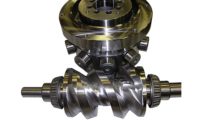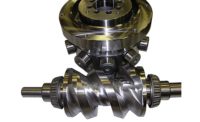There are several different ways to move something in a straight line. It’s important to understand all the options and choose the best solution for your application. Listed below are a few different possibilities for linear drive mechanisms:
- Pneumatic or hydraulic actuation
- Belt drive
- Screw drive
- Rack and pinion
- Linear motor
When choosing a drive mechanism there are a few characteristics to consider. Looking at your application in terms of these requirements will help you to make a logical decision about what drive mechanism to choose.
- Stroke
- Thrust force
- Repeatability
- Speed
- Acceleration
- Cost
- Control
The last item on the list, “Control”, is probably the most complicated but it’s the best place to start. Thinking about the type of control your application requires will quickly whittle down the possibilities of drive mechanisms. Does the application require movement between two points or are there several positions? For simple two position applications, the go-to solution is usually pneumatics. Mechanical devices like flow controls, shock absorbers and pressure regulators can be used to control the motion. It is also possible to go to several different positions by using pneumatic mid stops and long strokes are possible with a rodless cylinder design. But if your application requires more than two or three positions, it is probably best to start looking into a different drive mechanism.
Figure 1: SCHUNK LM pneumatic actuator with mid-stop
All of the other drive mechanisms on the list are driven by a motor and that opens up the possibility of having control over position and being able to program the movement of the drive mechanism. Now let’s switch gears and look at each drive mechanism. We’ll start with the belt drive.
Typical belt drives used in automation have a timing belt. They have a relatively low cost to stroke ratio because the timing belt is inexpensive and it’s easy to make in very long lengths. The max stroke of a belt drive is generally limited by the fact that the belt has to be tensioned. Standard belt drive actuators can usually be had in strokes up to 12m. The size of the belt, pulley and bearings dictate the thrust force capability. Larger belt drive actuators can be rated for over a ton of thrust force, but if you’re looking for a thrust mechanism then your best bet may be a hydraulic cylinder or screw drive. Belt drives are great for moving payloads at high speeds and accelerations. Larger belt drives with the proper linear bearing can accelerate at over 6 G’s and high speeds of 8 m/s. One downside to a belt drive is that it is not as precise as the other drive mechanisms. A general rule of thumb is that a belt drives can control position to about 0.1mm.
Figure 2: SCHUNK Gamma belt drive with up to 12m of stroke.
Screw drives on the other hand are great for high accuracy applications. A precision ball screw can easily get down to the micron level for positioning accuracy. Screw drives are also great for generating high thrust forces in the range of tens of thousands of pounds. Where screw drives usually fall short is in speed, stroke and cost. However, there are unique solutions available where a ball screw actuator can be 5m long and hit a top speed of 3 m/s.
Figure 3: SCHUNK Delta screw drive, up to 3 m/s at 5m stroke
Rack and pinion drives are similar to a belt drive in that they are great for moving payloads with high speeds and accelerations. Where rack and pinions really shine is extremely long strokes. Theoretically, there is no limit to stroke because there is no belt that has to be tensioned. The downside is that the rack is much more expensive than a timing belt. Rack and pinions are also unique in that the drive pinion moves with the carriage and that can be good or bad depending on the application. An interesting alternative to a rack and pinion is an “Omega Belt Drive” that acts like a rack and pinion but uses a timing belt instead of a rack to save cost.
Figure 4: SCHUNK Beta - Omega belt drive
Last but not least is the linear motor. It’s definitely not least in cost because it requires an expensive magnet track and linear encoder. But when it comes to speed, acceleration and repeatability, the linear motor is second to none. Linear motors can reach accelerations of up to 10 G’s and can achieve sub-micron precision thanks to the linear encoder. One area where the linear motor falls short is in thrust force. You can increase thrust force by making a larger linear motor, but that is expensive and there is no way to gain mechanical advantage through gearing. With a screw drive it is easy to generate very high thrusts with a small motor. A unique feature of the linear motor is that it is a wear free drive mechanism. All the other solutions require some mechanical contact to generate motion.
Figure 5: SCHUNK LDM linear motor.
In conclusion, each drive mechanism has pros and cons. It is best to look at each application in terms of what characteristics are required in order to choose the best solution.







